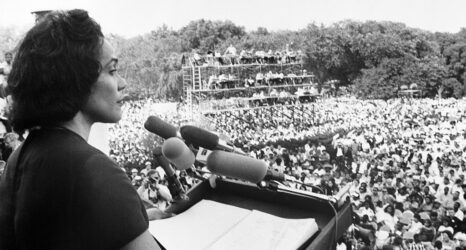An hour’s drive east of New Orleans along the Gulf of Mexico, there thrives the largely unknown historic Black settlement of North Gulfport and Turkey Creek Mississippi, established in 1866. Despite Interstate 49, which separates North Gulfport from Turkey Creek, these two historically connected communities still organize as one and together advocate against gentrification, environmental racism, and the unsustainable infill development of the Turkey Creek watershed, which community leaders insist makes their historic enclave of kinfolk dramatically flood prone.
For years, the founder of the North Gulfport Community Land Trust, Ms. Rose Johnson, has largely been the de facto spokeswoman for the North Gulfport community. Born and raised in the community, Ms. Rose is clear about the social reasons that the physical place of Turkey Creek provided safe haven to African Americans. She said that Blacks were not permitted to swim in the Gulf of Mexico, so “we played in the Turkey Creek” and
we also used it for baptizing and fishing. We didn’t have to worry about white people driving by and yelling, “Niggers go home!” and throwing stuff at us. Nobody else wanted this area, so our parents and grandparents created these little neighborhoods and churches.
It was a neck injury that conspired with fate to enlist Ms. Rose, a former employee of the Mississippi Department of Highway Patrol and Safety, into her current role of community and environmental activist. Her physical therapy program required that she walk every day in order to heal, and as she walked Ms. Rose began to take in very deeply how her neighborhood was changing for the worse—children with no safe places to play, abandoned lots owned by speculative developers taken over by drug dealers. She noticed that a wooden pallet company had moved into town and had become an eyesore, so she decided to fight to have it removed. With the backing of her church, as well as many signatures, she won that fight.
Her activism led Ms. Rose to the Sierra Club, or rather led the Sierra Club to her. They sent her to trainings where she learned how to frame development issues in the context of environmental justice. Already armed with a historical narrative unique to her voice and moral ethic, Ms. Rose was soon seamlessly connecting environmental justice, unsustainable development and gentrification, invoking history through her memories of North Gulfport.
She turned to the question of real estate at the urging of a friend who pointed out that “there’s white people buying up all our property and selling it back [to us].” Hearing this sentiment echoed through her church visits with others in the community, Ms. Rose heard about the concept of land trusts and decided such a trust would be a perfect solution for her community.
In 2004, Ms. Rose went to her first land sale. She caught on to how it worked and bought five parcels of land with money “cobbled together from too many people to count.” Eventually, the original Black owners of those parcels, who had been unable to pay the back taxes, were able to buy their land back from her. Not long afterward, however, Katrina hit the Gulf Coast—turning the Black community, once again, into what Ms. Rose calls an “invisible race”:
With a disaster, they reach to the top and start helping people at the top and nothing is left for the poor. African Americans are one of the most discriminated groups of people in the world. Katrina put a light on race, class and indifference. People were treated like we live in the third world, and this is the richest country in the world. We were so disappointed in our federal government. They didn’t show up in our community until October. It showed us what we knew: They don’t value us; we have to do for ourselves.
After tending to the immediate needs of her community, Ms. Rose turned to the larger picture. To her, it was clear that developers were buying up land, taking advantage of the chaos brought by the storm. “There are a lot of greedy people,” Ms. Rose says. “A lot of money is being made off Katrina.” Before the storm, she had initially decided to start small: They were going to raise money through block parties to try to stop the prospectors, buy up the property and then build affordable homes. Suddenly, however, after Katrina they found they had media attention, support and partners they hadn’t expected. Ms. Rose says:
People wanted to help. … Mercy Housing Corps, Healthy Builders, Youth Build, the Ms. Foundation for Women and the Enterprise Corporation of the Delta—all were helping. … I remember when Gloria Steinem gave a shout-out to Mississippi women in something I read.
Social movement scholars have long observed that, on a global scale, women are consistently the first to both become aware of and to take action on environmental problems in their communities. Ms. Rose’s analysis, intuition and narrative also reflect what the disaster literature has established—that without proper collective or private tenure systems in place, overexploitation of resources and environmental degradation are thought to increase a community’s vulnerability to disaster.
Now, several years after the storms and facing increasing health challenges, Ms. Rose remains committed to her goal of protecting African American communities and increasing their access to home ownership. When you have lost everything, says Ms. Rose, you know how truly “home is where the heart is”:
Home is for spiritual things to happen, for storytelling about who did what back in the day, a place to be secure. After Katrina, people were not secure, people were lost in so many ways. I saw how important home is. You know, not just your four walls. This is a place for Black people to protect themselves.
Excerpted from The Women of Katrina: How Gender, Race, and Class Matter in an American Disaster, edited by Emmanuel David and Elaine Enarson, published 2012 by Vanderbilt University Press. Reprinted with permission. www.VanderbiltUniversityPress.com.





